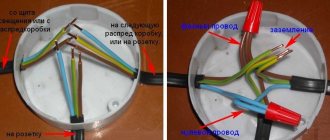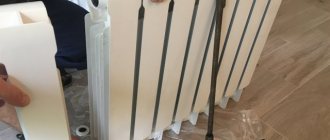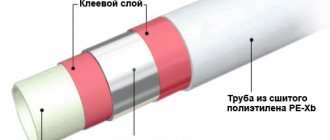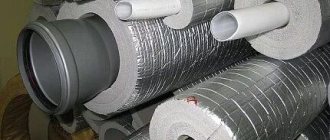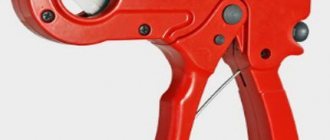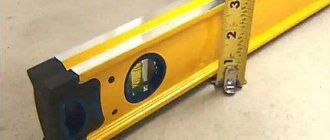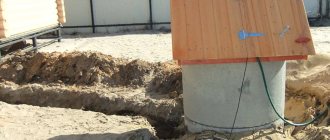In order for the water supply systems and the circuits through which the coolant circulates to flawlessly cope with their responsibilities, their components must be correctly assembled and correctly connected. The result of the plumbers' efforts must be airtight so as not to create problems for the owners and their neighbors. Do you agree?
All current methods of connecting pipes that ensure normal operation of the system are given in our proposed article. We have described in detail the technological options depending on the material from which the articulated parts are made and the category of the pipeline. Our tips will help you achieve the perfect result.
Socket connection method
A socket is a mounting extension designed to create a reliable connection. The principle is based on the fact that the end of a pipe with a smaller cross-section is inserted into a pipe of larger diameter. The connection is sealed by using a sealant placed in the socket or gluing with a composition that is resistant to water.
This type of connection is used when installing gravity pipelines for both internal and external sewerage systems, pressure external water pipelines and sewer networks.
Depending on the material of the pipes and their diameter, one of several existing options for socket joints is selected: with a sealing ring, without a ring, welding, gluing.
Connection without ring seal
Cast iron pipes are most often connected without an O-ring. The inserted pipe is shortened, the end is processed so that there are no nicks or mother-in-laws left in it. The tail part of the articulated pipe is inserted into the socket.
The resulting gap is filled with oiled hemp rope or tarred linen strands. First, the seal is placed in a ring and caulked into the socket by tapping it with a hammer on a special wooden spatula or screwdriver. It is important to ensure that the ends of the material do not get inside the pipeline.
Continue laying the sealant layer by layer until the socket is filled to 2/3 of its depth. For the last layer, an untreated sealant is used, because oils or resins will impair adhesion when filling the remaining space in the socket with cement.
To obtain the solution you need cement grades 300 - 400 and water for diluting it. The components are taken in a ratio of 9:1. The cement is compacted into the socket and covered with a wet rag for better setting.
The best quality seal is to use expanding cement. It is prepared just before use by adding water to a container with the main component in a 2:1 ratio, followed by thorough mixing and pouring into the socket. When hardened, the cement compacts itself and becomes completely waterproof.
Sometimes, instead of cement, an asbestos-cement mixture is used, made from M400 cement and high-quality asbestos fiber in a 2:1 ratio.
Water is added immediately before laying in an amount of about 11% by weight of the dry mixture. Instead of cement-based sealants, they use bitumen, silicone sealants, clay, the last layer of which is strengthened by applying bitumen or oil paint.
Socket connection with O-ring
This method is most often used when installing an intra-house sewer system. A rubber ring sandwiched between the socket and the pipe inserted into it creates a tight connection. Therefore, the method is not only simple, but also reliable.
The sealing ring to some extent smoothes out the differences in axes between the two pipes being connected. However, this is only the case if the axes on each meter of the composite pipeline are shifted by an amount that does not exceed the limits of the pipe wall thickness.
If this condition is violated, then the likelihood of leaks as a result of uneven deformation of the seal increases.
The procedure for connecting pipes with a socket. The parts to be joined are cleaned of dirt and dust. To avoid damaging the O-ring during installation, the smooth end of the pipe is pre-lubricated with soap, glycerin or special silicone grease. Oils cannot be used for this purpose. In addition to lubrication, a chamfer made at the connecting end of a pipe of smaller diameter at an angle of 15⁰ will protect the ring from damage.
To determine the depth of pressing of the free pipe shank into the socket, the sealing ring is temporarily removed. Then, placing the pipe in the socket until it stops, mark the place where the inserted part comes into contact with the socket.
During installation, the pipe is pushed out slightly in relation to the mark - by 0.9 - 1.1 cm. This distance will balance the internal stresses that appear in the system during temperature fluctuations.
Before placing the ring, it is recommended to dip it in soapy water and squeeze it a little. This will greatly simplify its insertion into the recess of the bell. In order to minimize the amount of misalignment, some manufacturers began to produce fittings with an angle of 87⁰ instead of 90⁰. The pipe enters the socket at an angle and the ring does not warp.
If there is a need to connect pipes made of different types of materials, adapter pipes are used. The size of the pipe, such as the internal diameter, must correspond to the outer section of the connected pipe. If the socket of a polymer pipe is connected to a cast iron pipe, a double seal is applied to the end of the second one and the pipe is mounted.
Composition and operating features
The basis of this plastic material is silicon; it is from this that silicone polymer is obtained. This seems unusual, because we are used to seeing silicon in the form of solid rock. In addition, the composition usually includes at least 4 more types of additives. The main difference between sealant for plumbing connections is the presence of a fungicide. This component provides an antiseptic effect and prevents mold.
Organic extenders are responsible for reducing viscosity, and thanks to mechanical fillers, for example, quartz or glass dust, chalk and others, adhesion improves. If it is necessary to obtain a certain color, then special dyes are introduced. The fact is that most silicones are not painted after hardening, so you should take care of the color scheme at the production stage. In general, the properties of this sealant largely depend on the ratio of the above components.
It is worth saying a little about the features of operation. If the composition contains a small amount of organic substances, then color can be given to the frozen joint only with special dyes. After opening the package, the substance does not lose its properties for several days if you close the tube - for example, you can plug the hole with a match.
It is quite problematic to work with narrow plates made of polyethylene, polypropylene, polycarbonate, PVC and fluoroplastic, since in this case adhesion will be insufficient. And only a limited range of compositions are suitable for interaction with wet surfaces. And yet, oddly enough, many plumbing silicone sealants do not interact well with acrylic. When in contact with synthetic materials, lead, zinc and copper, toxic fumes may be released, so be careful and be sure to read the included instructions before use.
2
In what forms is the sealant available?
Most liquid sealing compounds are available in special plastic tubes with a volume of 310 ml. Tubes up to 100 ml are in demand - for treating small areas. The tube is convenient because it is equipped with a special piston, like a syringe. It can be loaded into a construction gun, which is also used for mounting foams. It makes it easy to squeeze out the required amount of silicone. If the material is not completely used, then plug the hole in the package with an ordinary match so that it does not dry out inside.
Standard release form: 310 ml tube
For larger-scale work with pipes, plumbing sealants are available in large and soft file bags with a volume of 600 ml. To use them, guns of a different type are used, the principle is the same - as in a syringe. When choosing the required volume, try to calculate as accurately as possible the area to be treated.
Bonding parts of a plastic pipeline
PVC pipes are connected to a socket using the gluing method. For better adhesion, the socket inside and the tail of the inserted pipe are sanded to make the surface rough. Next, the chamfer is removed, and the treated parts are degreased using methylene chloride as a primer.
Before making a connection, check the pipes for compatibility. A pipe of smaller diameter should fit into the socket freely, but not too much. Then a line marks the boundary for applying glue - this will help to join the parts without errors.
On the surface of the elements being connected - 2 thirds of the socket recess, as well as the fully calibrated end of the pipe, glue is evenly applied in a thin layer. The pipe is inserted into the socket and turned a quarter turn to improve contact between the elements being connected. The joined parts are held until the glue sets.
Special aggressive adhesives are used for gluing polyvinyl chloride pipes. The process is similar to welding, but without high-temperature exposure; it is replaced by a chemical reaction, as a result of which the surfaces of the connected parts of the pipes are dissolved and transformed into one whole by copolymerization
The process takes only 20-30 seconds. If a uniform layer of glue appears at the joint, it is immediately removed using a piece of clean cloth. From gluing to complete stabilization of the connection and testing the pipeline for leaks, at least a day should pass.
Image gallery
Photo from
PVC pipes for bonding
Treating pipes before joining
Rules for applying glue to PVC parts
Joining glued parts
To repair existing pipelines, shaped parts are used in the form of repair couplings or products with an extended socket. A section of pipe is cut out, the ends are chamfered, and special glue is applied to the ends. The coupling is placed on the bottom of the pipeline.
A coupling with a long socket is placed on the top of the pipeline until it stops; if required, a shaped part is mounted on it. Move the coupling along with the shaped part down until it connects with the bottom of the pipeline. The sliding coupling is moved upward so that it covers the joint area.
A repair coupling differs from a regular coupling in that it does not have a side inside, so during the repair process the bell of any pipe can be moved through it
If even after this there is a leak, the joint is filled with silicone sealant. The bottom and top are determined depending on the direction of movement of the transported substance.
Plumbing thread
This is a synthetic material whose fibers are impregnated with a special non-drying compound. Has all the benefits of flax impregnated with sealant. Not subject to rotting, better protects against corrosion.
The use of plumbing thread as a sealant for connecting water pipes allows the positioning of elements with a reverse motion of up to 180⁰ (when using flax - only 90⁰). Incomplete tightening of elements is allowed, but sealing is maintained. Due to the fact that the thread is very thin, there is a large consumption of material. The only drawback is the high cost of the sealant.
Formation of threaded connections
A thread is a spiral or helical surface used to make a threaded connection. The use of threaded pipe connections in plumbing systems is a classic installation method.
It is used where it is possible to periodically monitor the joints, because threads tend to weaken under the influence of various factors.
To connect elements using threads, simply screw in two parts that have suitable cross-sections. They are also easy to disconnect - by unscrewing.
There are different types of pipe threads. Each of them is characterized by such parameters as the profile of the surface on which the thread is applied, direction, location, and number of thread starts.
The list of the most popular types of pipe threads includes:
- cylindrical or Whitward;
- conical;
- round;
- NPSM
The first of them is designated by the letter G and has 2 accuracy classes. The profile visually resembles an isosceles triangle. At the apex there is an angle of 55⁰. They connect pipeline sections with a diameter of up to 6 inches, which are subject to special requirements for tightness, using inch threads. For larger diameters, welding is used.
Inch-type conical threads are used for conical connections and to create joints of conical threads made on the outside and cylindrical inside the pipe. The letter R marks the external thread, the internal thread - Rc, LH - directed to the left. The sealant is the thread itself plus the sealant.
To connect frequently disassembled plumbing fittings: water stop taps, faucets, round threads are mainly used. It is designated by the symbols Kr.
The table summarizes the main thread parameters for a pipe that you can cut with your own hands. An important value for an inch thread is its pitch. This is the distance between adjacent ridges or troughs. Its value along the entire length remains unchanged, otherwise the thread will not work
The NPSM thread profile has a triangle shape and an angle of 60⁰. The size range in inches is from 1/16 to 24. This American standard thread is a type of cylindrical thread. It differs from the domestic one only in the size of the profile angle.
Advantages of silicone sealant
Silicone sealant contains silicone polymer and additives that increase its strength, adhesion and accelerate polymerization time. Silicone is mainly used for internal sealing of joints; its advantages are the following factors:
- High adhesion of the material to metals, plastics, ceramics, glass, enamel, stone.
- The material provides a long-term elastic connection without cracks.
- The temperature range of silicone is from -50 to +180 C, high-temperature domestic varieties are capable of operating at temperatures up to +260 C and briefly up to +350 C.
Cement
Sealing the joint with cement
When sealing a cast iron socket, Portland cement can be used. This substance dries quickly and provides reliable protection against leaks and accidents. For sealing, a high-quality grade of Portland cement is used. When working with Portland cement, it is necessary to apply the mixture over the joint.
A plumber's wrap is applied to the end of the pipe, and resin strands can be used for thick channels. The end is inserted into the socket, compacted and filled with Portland cement. This design will last for many years.
True, when dismantling it, your followers will have a lot of difficulties. But that is another story.
Baths
The bathtub is an important component of the bathroom. Today there is a wide selection of different bathtubs on the market. You can always choose a bathtub of a certain shape that will best fit into your room.
Standard bath sizes: length varies from - 150 to 180 cm, width from 70 to 85 cm, and height from 40 to 60 cm. Among modern bathtubs, there are ordinary rectangular, corner, and oval designs. You can choose a bathtub with a rather complex configuration and install it in the area of the room where its location will be determined by the design idea: in a corner, against the far wall, in the center of the room.
There are the following materials used to make bathtubs:
- cast iron (heavy cast iron is durable and strong, but the significant weight of such a bathtub - up to 120 kg - will require strong floors)
- steel (steel products are beneficial from an economic point of view, but their characteristic high heat transfer leads to the fact that the water quickly cools in the container)
- acrylic polymer reinforced with steel mesh (strong and flexible structure, capable of taking different shapes).
Another popular type of bathtub today is the very high sitz bathtub. The principle of performing bath procedures in such a bath is radically different from the usual method. You need to go into a dry bath, tightly close the special lid and fill the device with water.
Sitz baths are commonly used by older people who have difficulty taking a regular bath.
Joining pipes using resistance welding
To use this method of connecting pipes, you must have a welding machine. It can be mechanical or manual, but it must be equipped with a special tool that heats the elements to the required temperature.
When using socket technology, a sword-shaped device is used to connect pipes. It is a set made of metal and consisting of a sleeve designed to heat the outer surface of the pipe and a mandrel (pin) that melts the part from the inside.
An important point is the selection of the kit. Its parameters must correspond to the diameter of the assembly. The technology of socket connection of pipes using contact welding is simple:
- A restrictive clamp is placed on the inserted pipe. The distance between the edge of the pipe and the clamp should be equal to the depth of the socket plus another 2 mm. The difference between the inside diameter of the clamp and the outside diameter of the pipe being joined should be 0.2 mm.
- The kit is heated by first installing it on the device.
- Place the bell on the mandrel and the smooth tail of the pipe on the sleeve until it stops.
- Heating is carried out for the specified time.
- Remove the parts from the kit at the same time and connect them, holding the parts from moving until the melted material hardens.
Weld seams are inspected to identify possible distortions, voids, and unevenness of the seam. There should be no defects on the outer surface of the parts that appear if the permissible temperature is exceeded. Visually from the outside, the weld should have the shape of a symmetrical bead, having the same width and distributed evenly around the perimeter of the pipe.
The sleeve-mandrel set is selected individually for different diameters. The surface of the heating element is coated with a special composition, otherwise molten material will stick to it
The maximum height of the roller on a pipe with a wall thickness of up to 1 cm is a maximum of 2.5 mm. For pipes in which this size exceeds 1 cm, a roller height of 3–4 mm is considered acceptable. The edges of the welded joint can be offset relative to each other by no more than 10% of the pipe wall thickness.
Corrugated stainless steel
In this case, compression fittings with silicone O-rings are used to connect the pipeline elements. Thanks to corrugation, the fitting connection is extremely strong: it is almost impossible to tear the pipe out of the fitting without unscrewing the union nut.
Adapter from corrugated stainless steel to pipe thread.
Valves
Cast iron, steel or brass valves are necessary to prevent water from flooding your apartment in the event of various plumbing problems. Close the valve (by twisting it in the right direction) and proceed with the repair.
As a rule, in an apartment you need valves for the cold and hot pipelines. A control valve is installed at the main inlet or branch from the drain, which will help you shut off all water supply to carry out global repairs.
Faucets
Faucets provide a successful water supply system, forcing sinks to abandon the archaic separate “cold” and “hot” taps. The revolutionary design combines both faucets in one housing and mixes the water flowing out.
Mixers are:
- internal (the main unit of the device is hidden from the wall)
- external
Chrome and brass are used to make faucets, although to obtain a truly modern design it is necessary to opt for additional coating of chrome and brass with nickel coating or special enamel.
A joystick is invariably attached to the mixer - a lever for water intake equipment that regulates the water temperature and the intensity of its flow. By turning left/right, raising and lowering the joystick handle, you can easily keep water operations under control.
Another element of the mixer, which, however, is absolutely not considered mandatory to use, is the “ecological button”. The button allows you to significantly save water by limiting the flow of water entering the mixer and its temperature.
Accordingly, if you have such a button, you suddenly want to increase the pressure power and take a scalding shower, you just need to turn off this “filter”.
Designation of connecting thread type
It is often difficult to figure out in online catalogs which thread a particular part has - internal or external. This is especially true when there is no detailed drawing or photograph from the desired angle. In most cases, the abbreviations HP (external thread) and BP (internal thread) are used in part descriptions. For example, “1/2′ BP-HP-BP tee”.
Also, to designate the type of thread, the letters G (nut - internal thread, letter F in English) and Ш (fitting - external thread, letter M in English) can be used. For example, “Connection for towel rack is direct 1′-3/4′ G-W.”
The right-hand thread does not have any additional designations, but if there is a left-hand thread, then the letter L (L) is added to the abbreviation.
You might find it useful: “How to seal threaded water connections”
What is a fitting
Fitting
- This is a part of the pipeline connection. This name is “foreign”; they like everything shortened so that it is easy to pronounce while running with your chewing mouth. Here is our definition of a fitting from GOST 15763-2005:
“ Pipeline connection parts
: Body parts (fittings, elbows, tees, crosses, plugs, plugs), connecting parts (sleeve and installation nuts, lock nuts, bolts, flanges) and sealing parts (cutting ring, clamping ring, welded and soldered nipples, gaskets, etc.), providing an assembled connection of pipelines.”
An uninformative name, isn't it? Actually, this article was written in order to consider these very details in more detail.
The term “coupling” has a more specific meaning, however, it also has a fairly wide list of parts. coupling
(plumbing) - this is a part of connecting two pipes to each other. The connected pipes can be either the same or different types (and diameters).
Couplings are usually threaded (cast iron, brass or bronze); combined, for joining metal with polypropylene (separable and non-separable); for soldering (polypropylene or copper); compression, for connecting metal with various plastics (cross-linked polyethylene or metal-plastic), which are more often called collets.
In practice, couplings for metal-plastic pipes and cross-linked polyethylene pipes (PEX-AL and PEX) are more often called fittings, although the term “coupling” is also applicable to them.
Why is sealing needed?
Before selecting a suitable sealing material, it is necessary to understand whether the joints in pipelines always need to be sealed.
In water supply systems, joints are usually threaded. Considering that liquid is pumped through pipes with a certain pressure, it can leak out in the area of their connections.
Many people think that sealing is simply a matter of sealing leaks, but this process has many more functions. Modern sealing materials additionally secure threaded connections and protect them from penetration of moisture and corrosive substances and damage. They can replace mechanical locking elements and provide 100% sealing of the pipe even when the thread is not fully tightened.
To prevent leaks, pipe connections should be sealed already at the stage of installation and installation of the system.
